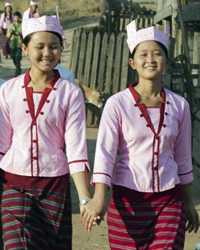Yintale in Myanmar (Burma)

Photo Source:
Asia Harvest-Operation Myanmar
|
Send Joshua Project a map of this people group.
|
| People Name: | Yintale |
| Country: | Myanmar (Burma) |
| 10/40 Window: | Yes |
| Population: | 11,000 |
| World Population: | 11,000 |
| Primary Language: | Yintale |
| Primary Religion: | Buddhism |
| Christian Adherents: | 0.01 % |
| Evangelicals: | 0.00 % |
| Scripture: | New Testament |
| Ministry Resources: | Yes |
| Jesus Film: | No |
| Audio Recordings: | Yes |
| People Cluster: | Karen |
| Affinity Bloc: | Tibetan-Himalayan Peoples |
| Progress Level: |
|
Identity
Confusion has arisen regarding the population of the Yintale, with some reputable sources listing only 1,000 people. This misunderstanding occurred after linguist David Bradley reported that only 1,000 Yintale people, living in three villages, were still able to speak their language in 2000.1 However, in 2007 Bradley clarified that the Yintale ethnic group contained 10,000 people, despite most having lost the ability to speak their language.
Location: Approximately 11,500 members of the Yintale tribe are distributed across the four districts of Bawlakhe, Hpruso, Loikaw, and Mese in eastern Myanmar's Kayah State. Most Yintale live between the Hpasawng mountains and the Salween (Thanlwin) River, about 50 miles (80 km) south of Loikaw.
Language: Yintale, which is now spoken by only about 1,000 people in three villages, is a variety of Western Kayah. The main village where the language is still used is called Wa Awng. Ywarthit village in Bawlakhe Township is another community still clinging to their mother tongue. Differences have been found between the vernaculars of these two villages, causing them to be viewed as separate dialects. Other Yintale villages do not use their language at all, causing the United Nations to place Yintale on their list of endangered languages. Even in the locations where the Yintale language is still spoken, it is mostly used by adults, with youth preferring to speak S'gaw Karen.
History
For centuries the Yintale lived in relative peace in northern Kayah State until the independence of Burma in 1948, when war broke out between the Burmese and various Kayah (Karenni) factions demanding their own statehood. The conflict has intensified in recent years during the Myanmar civil war. In June 2023 Mese, one of the townships inhabited by the Yintale, saw fierce fighting after two Karenni factions previously aligned with the government joined forces to fight against it. In December 2023, the Karenni seized control of the state capital, Loikaw, after the Burmese junta had ordered 353 airstrikes on the town, killing at least 82 civilians. At the time of this writing, the Karenni armies controlled about 80 percent of Kayah State, despite the Burmese junta having fighter jets and superior military hardware.
Customs
Although the Yintale view themselves as a distinct tribe with their own history and culture, they enthusiastically celebrate Kay Htoe Boe, the Karen New Year, which falls in April or May each year depending on the lunar calendar. Animistic rituals are performed during the celebrations around a sacred totem pole, at which “oracles and shamans read chicken bones to predict the year ahead by reading the holes of chicken thigh bones. Pigs are sometimes slaughtered to predict the health of the pole's spirit guardian by interpreting the health of the slaughtered pig's liver.” In 2016, a 62-year-old Yintale village elder, U Sot Rai, lamented that after bombing caused most people to move away, “We can't hold our traditional festivals every year because there are not enough people.”
Religion
Although most Yintale are professing Buddhists, the animistic rituals practiced by their ancestors continue to flourish, with one visitor observing: “Their most revered sites are not monasteries or pagodas, but sacred wooden pillars about 15 feet (4 meters) high that are erected in the ground. There are male and female pillars in separate locations…. Annual festivals include sacrificial offerings of medium-sized animals, such as pigs and goats. Festivals held every ten years include offerings of bigger animals, such as cattle, and are marked by the erection of a new pillar.”
Christianity
Despite the Gospel first reaching the area about 150 years ago, the faith has never deeply penetrated Yintale society, and nominal Catholic and Baptist believers make up most of the professing Christians. Today, about one out of every ten Yintale people identify as followers of Christ. After generations without the Bible in their language, the Yintale New Testament was published in 2020, although reports of its impact have yet to be seen.